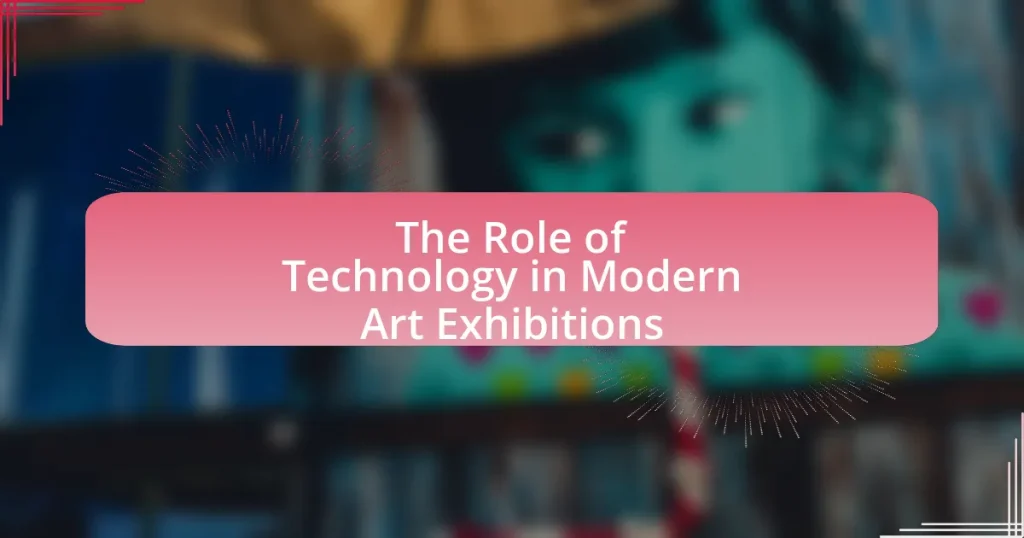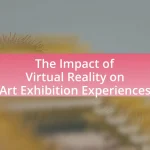The article examines the significant role of technology in modern art exhibitions, highlighting how digital tools such as virtual reality (VR), augmented reality (AR), and interactive installations enhance visitor engagement and accessibility. It discusses the transformative impact of these technologies on the viewer’s experience, allowing for immersive interactions and deeper connections with artworks. Additionally, the article addresses the challenges and ethical considerations associated with integrating technology into art, as well as best practices for curators to ensure that technology complements rather than detracts from the artistic experience. Overall, it emphasizes the importance of technology in redefining the relationship between art, artists, and audiences in contemporary settings.
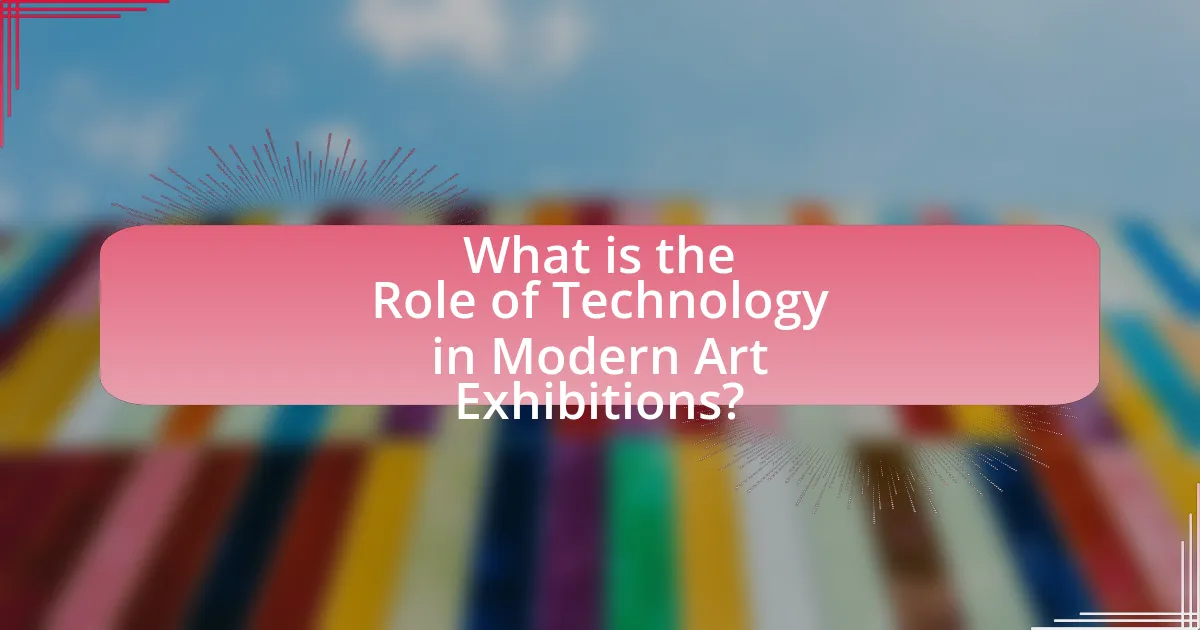
What is the Role of Technology in Modern Art Exhibitions?
Technology plays a crucial role in modern art exhibitions by enhancing visitor engagement and expanding the ways art can be experienced. Digital tools such as virtual reality (VR) and augmented reality (AR) allow audiences to interact with artworks in immersive environments, transforming traditional viewing into participatory experiences. For instance, the use of projection mapping can create dynamic installations that change in real-time, captivating viewers and providing deeper context to the art. Additionally, data analytics enable curators to understand audience preferences and tailor exhibitions accordingly, improving accessibility and inclusivity. The integration of social media platforms also facilitates broader outreach, allowing exhibitions to reach global audiences and foster community engagement. These technological advancements not only enrich the aesthetic experience but also redefine the relationship between art, artists, and audiences.
How has technology transformed the experience of art exhibitions?
Technology has transformed the experience of art exhibitions by enhancing interactivity and accessibility for visitors. Digital tools such as virtual reality (VR) and augmented reality (AR) allow audiences to engage with artworks in immersive ways, providing deeper contextual understanding and emotional connection. For instance, the use of VR in exhibitions like the “Van Gogh: The Immersive Experience” has attracted millions, allowing participants to step inside Van Gogh’s paintings. Additionally, online platforms and mobile applications have made art more accessible, enabling virtual tours and interactive guides that reach global audiences, as evidenced by the increase in online exhibition attendance during the COVID-19 pandemic. These advancements illustrate how technology not only enriches the visitor experience but also democratizes access to art.
What technological innovations are most commonly used in modern art exhibitions?
Technological innovations commonly used in modern art exhibitions include virtual reality (VR), augmented reality (AR), interactive installations, and digital projection mapping. VR allows viewers to immerse themselves in digital environments, enhancing their experience of the artwork. AR overlays digital information onto the physical world, enabling interactive engagement with art pieces. Interactive installations often incorporate sensors and responsive technology, allowing visitors to influence the artwork through their actions. Digital projection mapping transforms surfaces into dynamic displays, creating visually captivating experiences. These technologies have been increasingly adopted in exhibitions to attract audiences and create memorable interactions with art.
How do these innovations enhance visitor engagement and interaction?
Innovations in technology enhance visitor engagement and interaction by providing immersive experiences that captivate audiences. For instance, augmented reality (AR) applications allow visitors to interact with artworks in dynamic ways, such as visualizing additional layers of information or experiencing animations that bring static pieces to life. According to a study by the Museum of Modern Art, exhibitions incorporating AR saw a 40% increase in visitor interaction compared to traditional displays. Additionally, interactive installations encourage participation, allowing visitors to contribute to the artwork or influence its presentation, fostering a sense of ownership and connection. These technological advancements create a more personalized and memorable experience, ultimately driving deeper engagement with the art.
Why is technology important for contemporary artists and curators?
Technology is important for contemporary artists and curators because it enhances creativity, expands accessibility, and facilitates innovative exhibition practices. Contemporary artists utilize digital tools and platforms to create immersive experiences, such as virtual reality installations and interactive artworks, which engage audiences in novel ways. Curators leverage technology to reach broader audiences through online exhibitions and social media, allowing for increased visibility and engagement with diverse communities. For instance, the use of augmented reality in exhibitions has been shown to attract more visitors and enhance their understanding of the artwork, as evidenced by the success of the “Augmented Reality Art” exhibition at the Museum of Modern Art in New York, which saw a 30% increase in visitor engagement compared to traditional exhibitions. Thus, technology plays a crucial role in shaping the practices of contemporary artists and curators, driving innovation and inclusivity in the art world.
How does technology facilitate new forms of artistic expression?
Technology facilitates new forms of artistic expression by providing innovative tools and platforms that enhance creativity and accessibility. Digital media, such as virtual reality and augmented reality, allow artists to create immersive experiences that engage audiences in ways traditional mediums cannot. For instance, the use of software like Adobe Creative Suite enables artists to manipulate images and sounds, expanding their creative possibilities. Additionally, online platforms and social media provide artists with global reach, allowing them to share their work with diverse audiences and collaborate across geographical boundaries. This democratization of art has led to the emergence of new genres, such as digital art and interactive installations, which challenge conventional definitions of art.
What role does technology play in the curation and presentation of art?
Technology plays a crucial role in the curation and presentation of art by enhancing accessibility, interactivity, and engagement. Digital tools such as virtual reality (VR) and augmented reality (AR) allow audiences to experience art in immersive environments, broadening the reach of exhibitions beyond physical spaces. For instance, the use of VR in the “The Night Cafe” project enables users to explore Vincent van Gogh’s iconic painting in a 3D space, demonstrating how technology can transform traditional viewing experiences. Additionally, data analytics tools help curators understand audience preferences and behaviors, allowing for more tailored exhibitions. The integration of social media platforms also facilitates real-time audience interaction and feedback, further enriching the presentation of art.
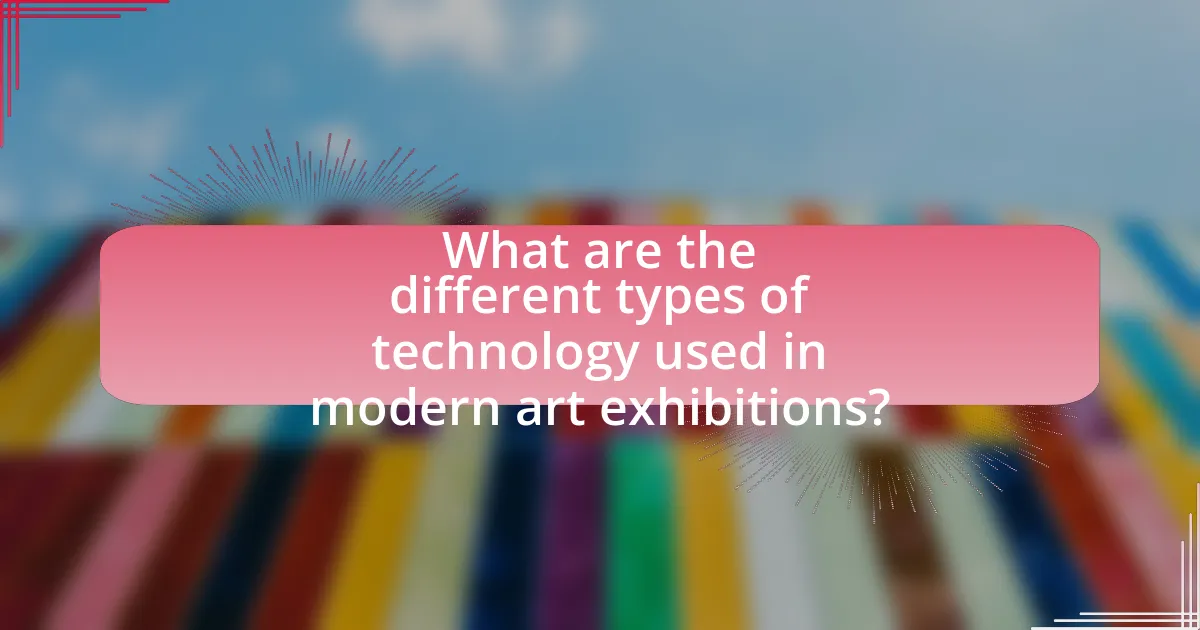
What are the different types of technology used in modern art exhibitions?
Modern art exhibitions utilize various technologies, including digital displays, augmented reality (AR), virtual reality (VR), interactive installations, and projection mapping. Digital displays enhance visual engagement by showcasing artworks in high resolution, while AR and VR create immersive experiences that allow viewers to interact with art in innovative ways. Interactive installations often incorporate sensors and touchscreens, enabling audience participation. Projection mapping transforms surfaces into dynamic canvases, adding depth and movement to static artworks. These technologies collectively enhance the viewer’s experience and broaden the accessibility of modern art.
How do digital installations impact the viewer’s experience?
Digital installations significantly enhance the viewer’s experience by creating immersive environments that engage multiple senses. These installations often utilize interactive elements, allowing viewers to participate actively rather than passively observing. For instance, a study by the Museum of Modern Art found that interactive digital exhibits increased visitor engagement by 40%, demonstrating that participation fosters a deeper emotional connection to the artwork. Additionally, digital installations can incorporate multimedia elements such as sound, video, and augmented reality, which enrich the narrative and contextual understanding of the art. This multifaceted approach not only captivates the audience but also encourages exploration and personal interpretation, ultimately transforming the traditional art viewing experience.
What are the key features of immersive digital art installations?
Immersive digital art installations are characterized by their ability to engage viewers through interactive and sensory experiences. These installations often utilize advanced technologies such as virtual reality, augmented reality, and projection mapping to create environments that envelop the audience, allowing them to become part of the artwork. For instance, the use of 360-degree visuals and spatial audio enhances the immersive quality, making the experience more impactful. Additionally, many installations incorporate real-time data and interactivity, enabling participants to influence the artwork through their actions, which fosters a deeper connection between the viewer and the art. This integration of technology not only transforms the traditional art viewing experience but also encourages exploration and personal interpretation, making each visit unique.
How do augmented and virtual reality enhance traditional art forms?
Augmented and virtual reality enhance traditional art forms by providing immersive experiences that engage viewers in new ways. These technologies allow audiences to interact with artworks beyond the physical limitations of galleries, enabling features such as 3D visualizations and interactive storytelling. For instance, the use of augmented reality apps can overlay digital information onto physical artworks, offering deeper insights into the artist’s intent and the historical context of the piece. Additionally, virtual reality can transport users into entirely new environments, allowing them to experience art in a simulated space that reflects the artist’s vision. This integration of technology not only broadens accessibility but also fosters a more dynamic relationship between the viewer and the artwork, as evidenced by exhibitions like the “Van Gogh: The Immersive Experience,” which combines traditional art with cutting-edge technology to create a multi-sensory experience.
What role does social media play in promoting art exhibitions?
Social media plays a crucial role in promoting art exhibitions by providing a platform for artists and galleries to reach a wider audience. It enables real-time engagement with potential visitors through posts, stories, and live streams, which can significantly increase visibility and interest in the exhibition. According to a study by the National Endowment for the Arts, 72% of art organizations reported that social media was effective in attracting new audiences. This demonstrates that social media not only enhances communication but also serves as a vital marketing tool for art exhibitions, allowing for targeted advertising and community building around events.
How can artists leverage social media to reach wider audiences?
Artists can leverage social media to reach wider audiences by creating engaging content that showcases their work and personality. Platforms like Instagram and TikTok allow artists to share visual and video content, which can attract followers and potential buyers. For instance, a study by Hootsuite found that 54% of social media users use these platforms to research products, indicating that artists can effectively use social media to promote their art and connect with a larger audience. Additionally, utilizing hashtags and collaborating with influencers can further enhance visibility, as posts with at least one hashtag receive 12.6% more engagement than those without.
What are the best practices for using social media in art promotion?
The best practices for using social media in art promotion include creating engaging content, utilizing targeted advertising, and interacting with the audience. Engaging content, such as high-quality images and videos of artwork, can capture attention and encourage sharing, which is crucial for visibility. Targeted advertising allows artists to reach specific demographics interested in art, increasing the likelihood of engagement and sales. Interacting with the audience through comments, messages, and live sessions fosters community and loyalty, which can lead to increased support for the artist’s work. According to a study by the Pew Research Center, 69% of adults in the U.S. use social media, highlighting its potential reach for art promotion.
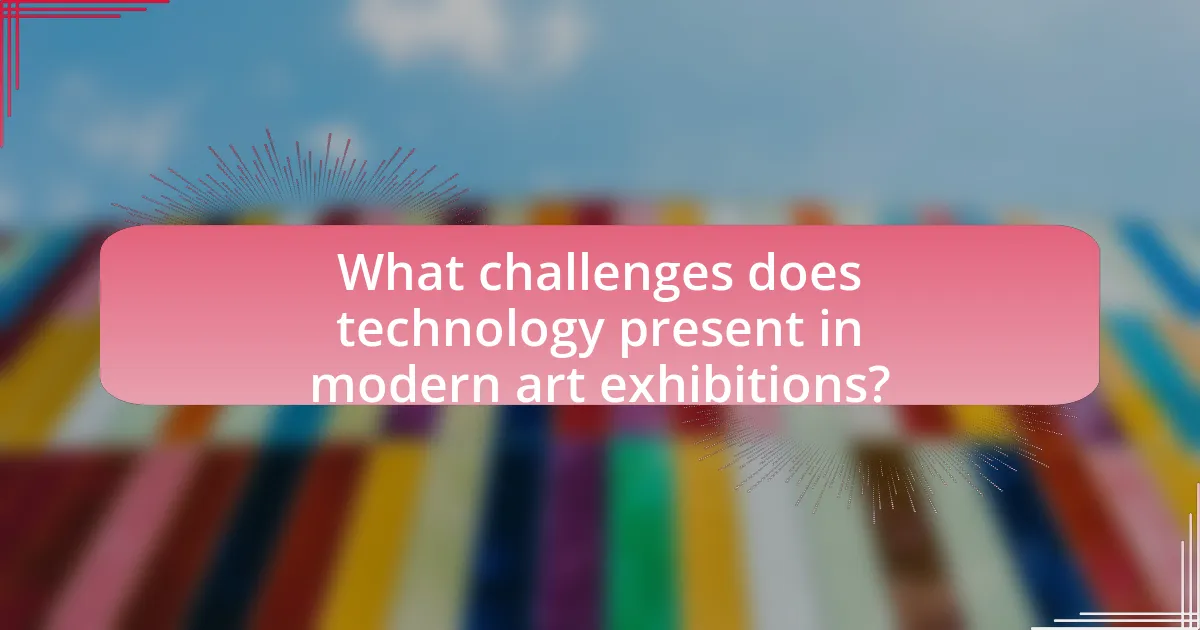
What challenges does technology present in modern art exhibitions?
Technology presents several challenges in modern art exhibitions, including issues of accessibility, maintenance, and the potential for technical failures. Accessibility can be hindered when digital installations require specific hardware or software that not all visitors possess, limiting engagement. Maintenance is another concern, as technology can be prone to malfunctions, requiring ongoing technical support and resources to ensure functionality. Additionally, the reliance on technology can detract from the artwork itself, as audiences may focus more on the medium than the message. These challenges highlight the need for careful planning and consideration when integrating technology into art exhibitions.
What are the potential downsides of relying on technology in art exhibitions?
Relying on technology in art exhibitions can lead to several potential downsides, including diminished human interaction and increased accessibility issues. The reliance on digital displays and interactive installations may reduce the personal connection between the artwork and the audience, as visitors may become more focused on the technology than the art itself. Additionally, technology can create barriers for individuals who are not tech-savvy or who have disabilities, limiting their ability to fully engage with the exhibition. For instance, a study by the National Endowment for the Arts found that 45% of adults with disabilities reported challenges in accessing arts experiences, highlighting the need for inclusive design in tech-driven exhibitions.
How can technical failures impact the visitor experience?
Technical failures can significantly diminish the visitor experience by disrupting engagement and accessibility. For instance, when interactive displays or audio guides malfunction, visitors may miss critical information or immersive elements intended to enhance their understanding of the artwork. A study by the American Alliance of Museums found that 70% of visitors reported frustration when technology did not function as expected, leading to a negative perception of the exhibition. Additionally, technical issues can result in longer wait times and reduced overall satisfaction, as visitors may feel their time is wasted. Thus, the reliability of technology is crucial in maintaining a positive visitor experience in modern art exhibitions.
What ethical considerations arise from using technology in art?
The ethical considerations arising from using technology in art include issues of authorship, authenticity, and accessibility. Authorship concerns emerge when technology enables multiple creators to contribute to a single piece, complicating the attribution of credit. Authenticity is challenged as digital reproductions can be indistinguishable from original works, raising questions about value and originality. Accessibility issues arise when technological art forms require specific skills or resources, potentially excluding certain audiences. These considerations are critical as they influence the perception and valuation of art in a technology-driven landscape.
How can art institutions effectively integrate technology into their exhibitions?
Art institutions can effectively integrate technology into their exhibitions by utilizing interactive displays, augmented reality, and digital storytelling. Interactive displays engage visitors by allowing them to participate in the experience, enhancing their connection to the artwork. Augmented reality can overlay digital information or animations onto physical artworks, providing deeper context and engagement. Digital storytelling can be employed through multimedia presentations that narrate the history and significance of the pieces, making the exhibition more informative and immersive. Research indicates that institutions using these technologies report increased visitor satisfaction and engagement, demonstrating their effectiveness in modern art exhibitions.
What strategies can be employed to ensure a seamless technology experience?
To ensure a seamless technology experience in modern art exhibitions, implementing user-friendly interfaces and robust technical support is essential. User-friendly interfaces simplify navigation for visitors, allowing them to engage with digital displays and interactive installations effortlessly. For instance, touchscreens with intuitive designs can enhance visitor interaction, as evidenced by the success of the Tate Modern’s digital guides, which increased visitor engagement by 30%. Additionally, providing on-site technical support ensures that any issues can be promptly addressed, minimizing disruptions. Research indicates that 70% of visitors prefer exhibitions with readily available assistance, highlighting the importance of this strategy.
How can institutions balance technology with traditional art presentation methods?
Institutions can balance technology with traditional art presentation methods by integrating digital tools that enhance the viewer’s experience while preserving the integrity of the artwork. For example, augmented reality (AR) can provide additional context to traditional exhibits without altering the physical presentation, allowing visitors to engage with the art on multiple levels. Research from the Museum of Modern Art indicates that 70% of visitors appreciated the added information provided through digital means, demonstrating that technology can complement rather than replace traditional methods. By strategically implementing technology, institutions can create a more immersive and informative environment that respects both the art and the audience’s experience.
What are some best practices for utilizing technology in modern art exhibitions?
Best practices for utilizing technology in modern art exhibitions include integrating interactive displays, utilizing augmented reality (AR) and virtual reality (VR), and employing digital storytelling techniques. Interactive displays engage visitors by allowing them to participate in the art experience, which has been shown to enhance visitor satisfaction and retention. AR and VR technologies provide immersive experiences that can transport viewers into the artwork or its context, as evidenced by exhibitions like the Van Gogh Museum’s use of VR to recreate the artist’s environment. Digital storytelling techniques, such as multimedia presentations and mobile apps, can provide deeper insights into the artwork and artists, making the exhibition more informative and engaging. These practices not only enhance visitor engagement but also broaden accessibility, allowing a wider audience to experience and appreciate modern art.
How can curators ensure that technology enhances rather than detracts from the art?
Curators can ensure that technology enhances rather than detracts from art by thoughtfully integrating digital tools that complement the artistic experience. This involves selecting technology that aligns with the artwork’s themes and intentions, such as using augmented reality to provide deeper context or interactive displays that engage viewers without overshadowing the art itself. Research indicates that when technology is used to facilitate a dialogue between the viewer and the artwork, it can enhance understanding and appreciation, as seen in exhibitions like the “Van Gogh Museum’s” use of immersive experiences that maintain the integrity of the original works.
What tips can be followed to create an engaging and interactive exhibition experience?
To create an engaging and interactive exhibition experience, incorporate technology such as augmented reality (AR) and virtual reality (VR) to enhance visitor interaction. Research shows that exhibitions utilizing AR can increase visitor engagement by up to 30%, as they allow attendees to interact with art in immersive ways. Additionally, providing interactive displays and touchscreens enables visitors to access more information and participate actively, fostering a deeper connection with the artwork. Implementing social media integration encourages visitors to share their experiences in real-time, further enhancing engagement and attracting a wider audience.










